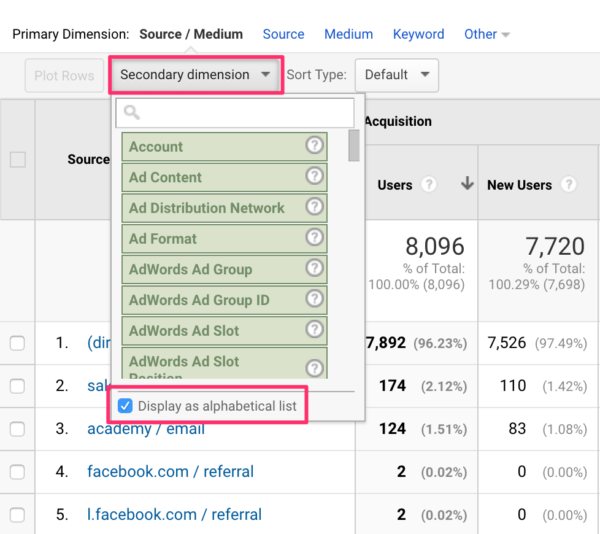Understanding the 'Secondary Dimension' in Google Analytics: Complete Review
Wiki Article
Navigating the Depths of Secondary Measurement in Google Analytics: A Thorough Expedition on Its Functionality
Additional measurements, though relatively straightforward at first glance, nurture a wide range of untapped possible waiting to be taken advantage of. As we get started on this journey to explore the nuanced capability of second dimensions, we will discover just how this attribute can light up patterns, unveil connections, and ultimately pave the means for notified decision-making in the electronic landscape (what is a “secondary dimension” in google analytics?).Recognizing Second Measurements in Google Analytics

Recognizing exactly how additional dimensions work is critical for leveraging the complete power of Google Analytics. These measurements help you address more complex concerns regarding customer actions and the efficiency of your website content and advertising initiatives. For instance, you can utilize second dimensions to evaluate which devices or browsers are most typically made use of by site visitors that buy, or to contrast the bounce prices of various traffic resources. By combining main metrics with secondary measurements, you can acquire valuable insights that drive informed decision-making and optimization approaches - what is a “secondary dimension” in google analytics?.
Leveraging Secondary Dimensions for Information Evaluation
Structure upon the fundamental understanding of how second measurements boost data analysis in Google Analytics, the application of these additional layers of details ends up being paramount in removing useful understandings for educated decision-making and optimization approaches. By leveraging secondary measurements, analysts can dig much deeper right into the performance metrics by adding even more context to the key dimensions, hence uncovering covert patterns and connections that could not be apparent in the beginning look. This much deeper degree of evaluation enables businesses to better comprehend customer behavior, determine patterns, and pinpoint areas for renovation.
Moreover, additional measurements provide a more thorough view of the information, permitting for segmentation based on different criteria such as demographics, tools, web traffic resources, and a lot more. This division facilitates a much more granular evaluation, enabling services to tailor their methods and campaigns to specific target market sectors for enhanced targeting and customization. Essentially, the strategic use of additional measurements empowers organizations to make data-driven decisions that drive growth and success in the electronic landscape.
Advanced Techniques for Secondary Dimension Implementation
Checking out elaborate approaches to harness the full capacity of additional dimensions in Google Analytics elevates the depth and elegance of information analysis for critical decision-making. One sophisticated technique for implementing secondary dimensions is the use of custom-made dimensions. In addition, integrating secondary measurements with sophisticated sectors can offer even more granular insights by using several layers of division to the data.Interpreting Insights With Second Dimensions

When translating understandings via secondary dimensions, it is necessary to think about the context of the data and just how different measurements engage with each other. Understanding which certain traffic resources lead to higher conversion prices or identifying which gadgets individuals like for making purchases can offer workable understandings for maximizing advertising and marketing projects and enhancing overall website performance. By very carefully analyzing the data with secondary dimensions in mind, organizations can make informed decisions that drive meaningful results and improve their digital existence.
Enhancing Efficiency With Second Measurements

One essential method to maximize efficiency with secondary dimensions is by segmenting data a lot more granularly. This enables you to isolate certain elements that might be affecting your metrics and gain a far better understanding of what drives success or failure in your electronic campaigns. As an example, by integrating second dimensions such as 'gadget classification' and 'touchdown web page,' you can determine which gadget kinds are most reliable for particular landing pages, enabling you to customize your methods accordingly.
In addition, utilizing secondary dimensions can go now aid you determine patterns, patterns, and relationships that might not be apparent when assessing information with primary measurements alone. This much deeper level of evaluation can lead to even more informed decision-making and eventually boost the general performance of your internet site or digital marketing projects.
Conclusion
In final thought, second measurements in Google Analytics play a critical duty in boosting data analysis and offering deeper understandings into website efficiency. By utilizing innovative methods and translating the information effectively, businesses can maximize their methods and enhance total performance. Recognizing the functionality of additional measurements is essential for making educated decisions and driving success in the electronic landscape.By leveraging additional dimensions, analysts can delve deeper right into the performance metrics by including more context to the key dimensions, hence discovering concealed patterns and relationships that might not be noticeable at very first look. One sophisticated technique for executing secondary dimensions is the usage of customized dimensions.Having actually understood innovative strategies like customized measurements and regex for secondary dimension application in Google Analytics, the following vital step is translating the useful understandings derived via these innovative data segmentation approaches. Translating understandings with additional measurements entails analyzing the relationships between the look at these guys main and second measurements chosen, discovering patterns, patterns, and correlations that may not be immediately evident when looking at the information in its totality.When analyzing insights with additional measurements, it is necessary to think about the context of the data and how various dimensions connect with each other.
Report this wiki page